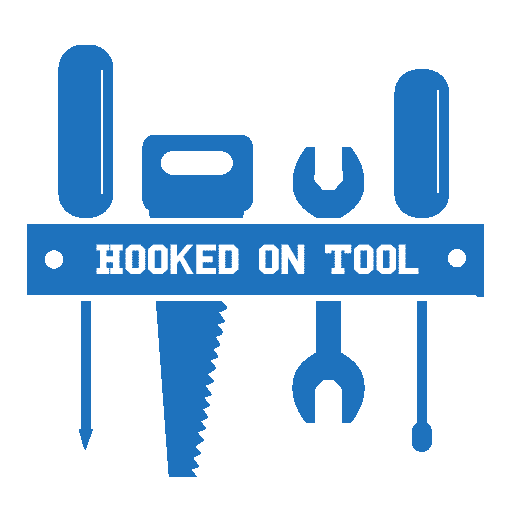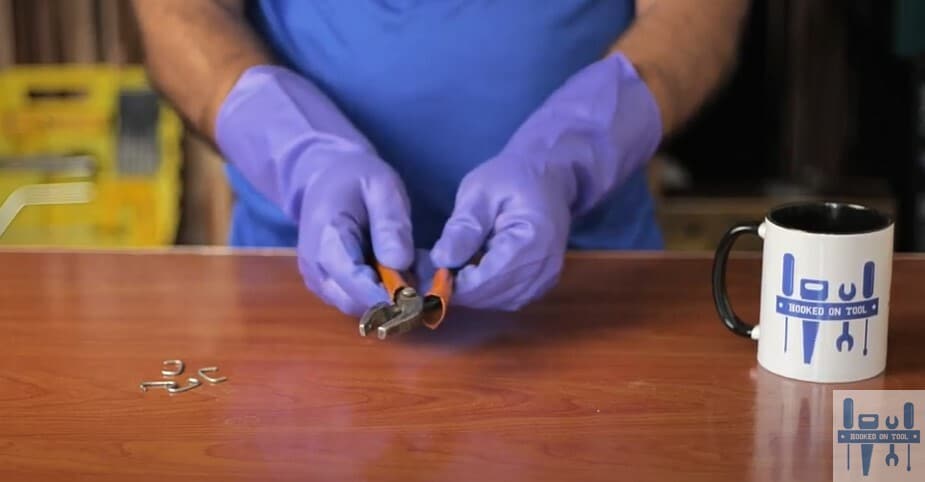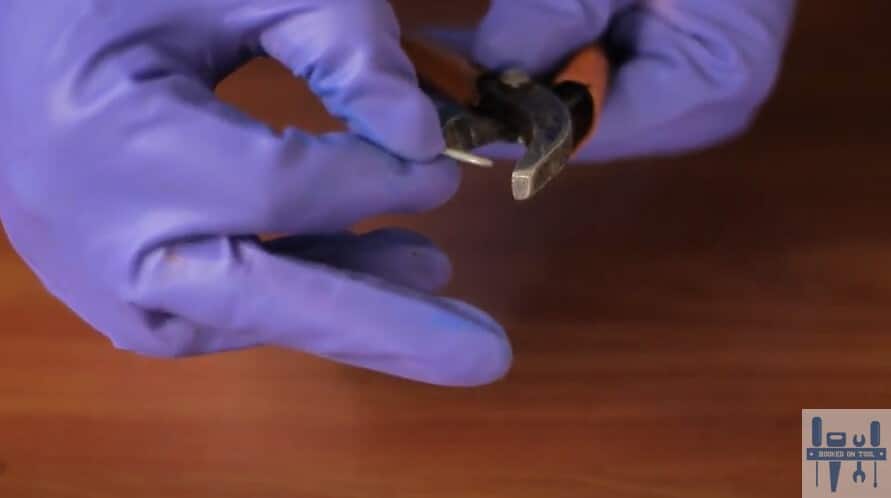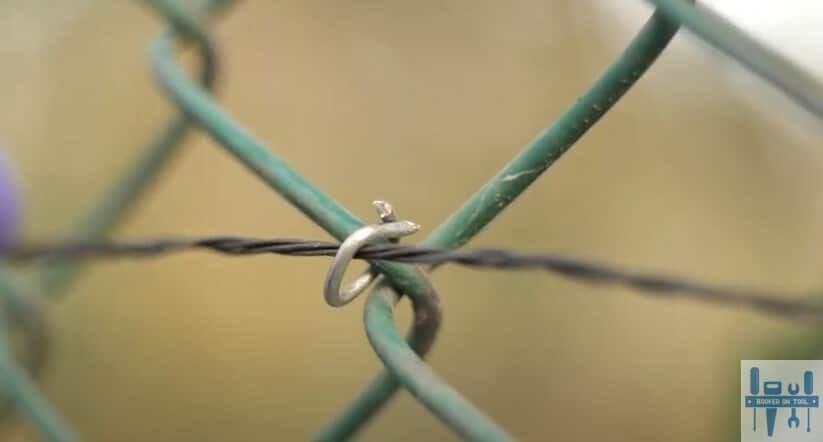
Even though I’ve completed a ton of DIY projects over the years, I still find new tools and cool variations of exciting tools in the market. Sometimes, these variations or tools are far less “practical,” and the dealer is only playing on the eye-catching design.
However, every once in a while, I do come across some amazing accessories that transform my whole perspective on DIY projects. The same happened when I got my hands on some hog rings. I work quite frequently with leather and cloth, and these rings changed the game for me.
I had no idea how simple it was to create a robust bond between cloth and leather when using the hog ring. However, I did have to spend a lot of time learning how to use the hog ring pliers. So, that took a bit of breath out of me when managing my DIY projects.
What Is A Hog Ring?
I’ve seen a fair share of queries on what a hog ring is or how to use the hog rings. Beginners often find themselves confused about the usage of the hog rings, and I was in the same shoes for quite a while. However, once you get the hang of them, it becomes rather effortless.
Hog Rings
You can think of hog rings as thick metal staples that are curved into a C shape. These staples can then be put inside the hog ring pliers and forced to close to form an O shape. Whatever material you try to lock up within this O shape stays together, and you don’t have to worry about the metal bending.
Even under extreme pressure and temperatures, the hog ring will maintain its shape, and you don’t have to worry too much about a loose connection. As long as you’re confident that your hog ring is closed, you’re sorted out completely.
I’ve recently come to know that there is quite a story behind the name “hog rings.” Apparently, these rings were initially used to put through the noses of male pigs (hogs), hence the name “hog rings.” The main intention here was to make the hogs behave.
However, over the years, many woodworkers and farmers have found incredible uses for hog rings. You’ll find these rings to be pretty common when it comes to creating a sturdy bond between fabric and metal pieces. So, if you’re also looking for something to tie up your sofa cushions, hog rings are for you.
How To Use Hog Rings
Using hog rings doesn’t require any expert knowledge, and all that you need to do is to get the material through the hog ring and close them up with hog ring pliers. The shape of the hog rings pliers is a bit slim, and there are insertion points inside the teeth to clamp down on the hog rings.
If you’re working with a metal fence and want to attach a metal wire or any fabric to the fence, just hold that against the fence and use the hog rings pliers along with the hog rings to clamp down on the fence. Your only focus should be on creating an “O” shape with the hog rings.
Ignoring this basic requirement will only lead to more issues, and you will only develop a poor connection with the fabric or the metal wire that you wish to attach to the metal piece. So, try and put a bit more force when it comes to clamping down the hog ring with the pliers.
You can also use standard pliers in some situations, but I will recommend against those, as it can be much harder to close the hog rings if you don’t have the hog ring pliers. So, take a bit of a hit to the budget, and get the pliers.
Applications
There are a ton of things that you can do with hog rings like
- Packaging
- Furniture
- Car seats
- Construction sector
- Farming sector (cages)
- Traps
There is so much more than you can do with the hog rings, and the only limit is your imagination. Think of hog rings as metal staples that can hold anything that you’d like. The strength of the grip is beyond your standard items, and it is pretty easy to manage most projects with hog rings.
I personally use hog rings to help attach accessories to my fence or to fasten up the cushion covers on my furniture. If you’re planning on using the hog rings in a similar manner, then that is not that hard to accomplish.
Attaching Accessories To Your Fence: You can grab a small piece of metal wire and put it against the fence. This metal wire will serve as the holding point where you can attach any accessory that you like. From there, you can use hog rings (placed inside the pliers) to clamp down the metal wire.
Make sure to create multiple connections with hog rings, and I usually use around three hog rings per metal wire to develop a good foundation. This foundation can then be used as a hanging point for my accessories, and you can also get through some great projects in a similar manner.
Fixing Cushion Covers: For the longest time, I had to struggle with cushion covers as they kept slipping away from the foam. No one likes baggy covers that clump up on one side of the sofa. So, if you’re in the same boat, some hog rings can help you out right away.
You can add the hog rings to the pliers and then tighten up the cushion covers. Just make sure that the leather and the cloth pass through the metal ring. So, have that in mind and clamp that around the foam. It won’t be that much of a hassle to manage the cushion covers from this point onwards.
Ideally, two rings on each side of the cushion will have you sorted out. So, don’t try to go too cheap when it comes to managing cushion covers. Otherwise, you’ll only be creating more hassle for yourself down the road.
The Pros
The good thing about hog rings span many dimensions. Starting with the power and the robust build, you will not have to worry about the hod rings breaking even under extreme pressure. Similarly, you will not have to worry about the temperature side of things.
Moreover, the versatility of these rings will also put you ahead in several projects. There is no “defined” or “perfect” method of using the hog rings. Everything comes down to how you’re planning on addressing the project.
The Cons
The downside of using the hog rings is that they can be hard to manage when you don’t have the hog ring pliers. It takes quite a bit of strength to clamp down on the hog rings, and you will likely tire yourself out when managing the hog rings.
Still, that is the price that you will have to pay to get a sturdy bond. A bit of forearm workout won’t be the end of the world, either. So, just put in the hassle, and you’ll at least feel strong after feeling a bit sore for a few days.
Note: You can also get some variations for the hog rings as well. These variations include the D-type and the C-type rings. The C-type rings are easier to handle, but experts often stick with the D-type rings for better work efficiency.
If you’ve not tried either one, then you shouldn’t wait too long before trying both. Otherwise, you won’t be able to figure out which one works perfectly for you. Similarly, you can ask the local experts to help you out when it comes to gaining some experience. So don’t hesitate to reach out.
The Takeaway
I’ve listed some specifics on what hog rings are, how you can use them, and the pros and cons associated with these metal staples. So, if you’re new to the game and don’t know how to manage the hog rings, the above details should give you a decent idea.
You’ll need some technical know-how to use these rings, so don’t try to disregard them. When it comes to forging a solid and reliable bond between cloth and metal, these tools can be incredibly helpful. So make sure to try, and everything will work out for you.
I’ll say it again: spend some time with the local specialists as well. You will be well ahead of the learning curve if you invest a few hours per week in local workshops.
And hence, don’t wait to determine how to employ hog rings effectively and how to modify your projects to accommodate their utilization.
Hopefully, you will be able to speed through the projects where hog rings are involved. However, if you have any confusion around this subject, just leave them below in the comment section. I’ll be sure to go over your concerns and guide you accordingly.





